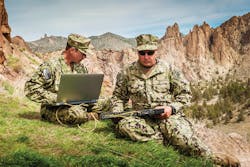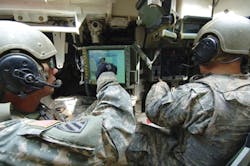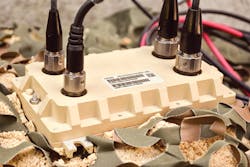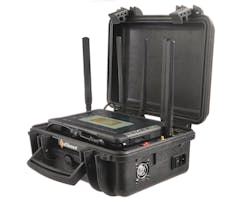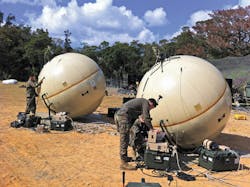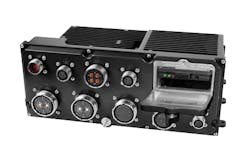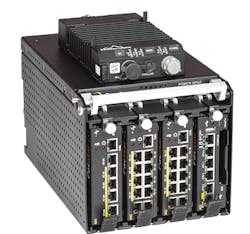Modern electronics hardware and software combine in compact communications systems to meet ever-increasing demands for real-time, high-speed information sharing.
Aerospace and defense missions, including day-to-day activities, increasingly rely on information. Especially important is one's ability to share much-needed data - whether by voice, images, or video - and do so reliably, securely, and in real time. The efficient exchange of safety- and mission-critical information is no mean feat, especially in remote and harsh environments, and requires a combination of robust and reliable electronics hardware and software.
Information is a critical component in virtually all military and aerospace missions today; yet, communications bandwidth limitations often plague mil/aero applications and end users. Bandwidth challenges can be costly, and cause gaps in intelligence gathering and dissemination that could put missions and lives in jeopardy.
Much is being done in an effort to remedy such challenges: Industry technology firms continue to advance data communications and networking technologies, while mil/aero organizations work to deliver more modern, efficient tools in the hands of deployed assets - mil/aero personnel and platforms.
Networking needs
"Today, information sharing is absolutely critical as a core means to ensure mission success," explains Charlie Kawasaki, chief technology officer at Pacific Star Communications Inc. (PacStar), a Portland, Ore.-based provider of tactical and deployable communications equipment. "Nearly every operation is highly dependent on information systems to ensure mission command availability, to achieve and maintain situational awareness, to ensure that the needs of soldiers are met, and to coordinate with coalition partners."
Applications such as mission planning and coordination, intelligence, fire support, combat support, and logistics all rely heavily on Internet Protocol (IP) networks, Kawasaki continues. "Large amounts of communications bandwidth are required throughout the globe, even in locations with austere, missing, or damaged infrastructure. Information sharing is so important, the question is not 'if' but 'how'."
Aerospace and defense organizations, including militaries worldwide, are opting to adopt hardware and software products from the commercial market. By fielding commercial off-the-shelf (COTS) technologies in lieu of purpose-built, one-off, and proprietary products, they aim to benefit from the commercial world's rapid pace of technology advancement and cost-saving economies of scale. COTS adoption is not without its caveats, however, especially when it comes to communications.
"More and more data and networking capabilities are being pushed out to the edge of the field with the help of virtualization," Kawasaki says. Gigantic enterprise- class software and hardware capabilities are virtualized on very small-form-factor (SFF) servers and networking equipment to increase availability. Yet, this trend results in two side effects: more requirements and an ease-of-use problem.
Rugged requirements
Not too many years ago, a large program fielded satellite terminals to provide warfighters access to the Secret Internet Protocol Router Network (SIPRNet) and Non-classified Internet Protocol Router Network (NIPRNet) in the field, Kawasaki says. "Hundreds of them, out in dusty field. Half of them were off- line most of the time, and there was not enough military communications expertise to operate them out in the field.
"Most systems you buy from traditional systems developers go from the factory to the air-conditioned space where they are to be used," Kawasaki says. In contrast, COTS equipment used in aerospace and defense applications are bounced around, are relocated again and again, endure temperature extremes, are exposed to the elements, and so on. "COTS technologies from large OEMs aren't necessarily qualified to run in those environments."
In addition to providing effective communications, solutions for aerospace and defense must meet high standards of environmental testing for shock, vibration, and temperature. Compliance with and third-party testing to MIL-STD-810G and MIL-STD-461F are critical to assure reliably in real operations in remote or mission-critical settings, Kawasaki says. "While these types of standards have been around for quite some time, they have been infrequently applied to COTS equipment. Systems designed and independently tested to standards provide a strong level of assurance to organizations and programs that require reliability in mission-critical systems."
Third-party validation can be a crucial part of rugged military systems design. "We have seen some organizations design to meet military standards, and we go the extra step and have a third party evaluate and qualify. If I was a program manager, I wouldn't settle for anything less. This is mission-critical stuff and it can be incredibly difficult to get replacements out in the field; if a critical parameter is reducing size, weight, and power (SWaP), it defeats the purpose to bring back-ups."
SWaP
"As part of its modernization efforts, the Army continues to improve current and future SATCOM systems to reduce size, weight, and power (SWaP) requirements, as well as increase throughput, network extension, and operational versatility," say officials of the U.S. Army Program Executive Office Command Control Communications - Tactical (PEO C3T) division at Aberdeen Proving Ground, Md.
"SWaP is an evergreen challenge for warfighter communications," Kawasaki says. "Communications equipment can never be too small, too light, or too power efficient - all else being equal. As new capabilities for information sharing and cyber security push to the edge of the network, requiring more bandwidth and computing power, this only adds to SWaP challenges.
"In the past, tactical/deployed organizations had two main methods to deploy communications technologies," Kawasaki continues. "Option one was to use standard commercial off-the-shelf, 19-inch, rack-mount networking equipment installed in transit cases - which is large, heavy, power hungry, and not designed or ruggedized for transport.
"Option two was to use government-designed or specialized rugged equipment that is extraordinarily expensive, and thus was restricted for use in only the most critical and demanding environments," Kawasaki says.
Today, however, organizations can benefit from:
- COTS embeddable, small-form-factor circuit boards based on commercial technology, which can be packaged into ruggedized systems at a fraction of the cost of developing purpose-built systems. Using these systems, organizations gain the benefit of commercial sector technology economics, while also benefiting from the right level of ruggedization required to meet mission objectives.
- Virtualized versions of networking appliances. In the past, networking technologies such as routers, switches, firewalls, Wi-Fi controllers were only available in 19-inch, rack-mount solutions. Today, well-known networking technology vendors are rushing to create software versions of these technologies, making their deployment on COTS, small-form-factor, single-board computers possible. In addition to reducing the SWaP of a single host, a single host can often run multiple services, collapsing a number of network appliances into a single SFF server running multiple virtualized machines.
Ease of use and training
To leverage COTS technologies, many warfighter programs create systems from hardware and soft-ware components that are readily available and in use or derived from enterprise information technology (IT) or network systems, Kawasaki says. "This approach is unquestionably the right one - every day tens of thousands of engineers go to work adding many new features and capabilities that our warfighters can benefit from. However, this blended hardware/software approach has also introduced an unintended negative side effect for the operators - comms specialists and signal officers - in the field: a usability nightmare and an intractable learning curve."
The general move to COTS by the U.S. government prompted enterprise companies to repurpose enterprise-class electronics for use in the field. "It is the equivalent of taking a phone system the magnitude of a major communications company, putting it in a small box, and foisting on operators incredibly complex capabilities and features, many of which are not appropriate for in the field," Kawasaki says. "Approximately 80 percent of features added to COTS software/hardware systems are seldom or never used, particularly in deployed operations."
Usability is a challenge; it's a human factors issue and tricky in the communications arena, Kawasaki explains. "Now you are deploying accelerated mission command capabilities, including video teleconferencing, out in the field, and the U.S. Department of Defense (DOD) is constrained in its ability to send trained operators with all that technology."
Complexity is a big challenge. Soldiers typically are trained in just a few weeks, which is not the same as an IT professional that has studied the technology for years, Kawasaki says. "Plus, they are operating under pressure and in harsh environments, setting up [complex communications and networking equipment] in theater with people asking why comms aren't up yet."
PacStar engineers have encountered this usability conundrum firsthand: In one instance, an integrated communications system included a firewall, wireless access point and encryption gateway, a router and switch, voice gateway, server with a PBX, e-mail and user directory system, and a digitally monitored uninterruptible power supply (UPS).
"Each system component [was] designed and manufactured by a different COTS vendor, and each with its own user interface and set of commands," Kawasaki says. "The firewall component alone came with 5,000 pages of documentation, and required the operations staff to undertake multiple training programs. Moreover, this was just one of a set of eight devices integrated into a single system.
It can be impossible to make this approach work for rapidly changing conditions in the military. "While integrated systems can be pre-configured to provide significant baseline capabilities, adapting such systems to rapidly changing situations in the field requires extensively trained signal officers," Kawasaki explains. "In addition to the downward budgetary pressure on today's armed forces, future network plans envision a dramatic expansion of the number of soldiers equipped with network access. Combined, these trends will widen an already critical gap in the availability/supply of operators capable and trained in operating and managing these advanced systems - a gap that is partially filled through reliance on expensive civilian contractors."
Software approach
An effective solution is to hide systems complexity by using unified management software interfaces that expose only the features needed, Kawasaki says. This can remove 80 percent of unnecessary features. PacStar takes a "single pane of glass" approach, using its IQ-Core communications management software, to present to the operator just those features and capabilities they need to worry about in the field and hide the enterprise features.
"COTS solutions can be deployed with application software that integrates the view of systems from a management perspective and, when restricted to critical use cases, can be delivered in relatively lightweight implementations," Kawasaki says. "By making these types of capabilities available in the field, it enables systems support in the field by operators with little training - closing the gap between the complexity of the systems and the availability of capable operators."
Officials of the Army Project Manager Warfighter Information Network-Tactical (PM WIN-T) at Aberdeen Proving Ground, Md., have placed several follow-on purchases for additional deployments, and also have worked with PacStar to add capabilities to the company's software. PacStar won a three-year, $6.2 million contract to support WIN-T Increment 1, the Army's current and future tactical communications network backbone and arguably the largest tactical communications program in the world.
WIN-T enables assured, mobile battlefield communications by delivering to the warfighter a range of data, voice, and video communications and network management tools for establishing and managing communications. This new contract effectively extends the use of PacStar's IQ-Core Software by mobile network communications units across the U.S. Army, officials say.
"The U.S. Army - and the military as a whole - requires technology that solves complex battlefield communications challenges and enables soldiers to focus on fighting the battle, not the network," says PacStar CEO Peggy Miller.
Holistic engineering
"Sensors - and by that I mean anything electronically sensing the world, from radar and sonar to electro-optics and high-speed video cameras - are producing more and more data for intelligence, surveillance, and reconnaissance (ISR)," says Paul Davis, director of product management at the Curtiss-Wright Defense Solutions division in Dayton, Ohio. Inefficient bandwidth, between electronics systems and within individual electronics, is a big problem, especially given the rate of information capture today and the critical need for information sharing in aerospace and defense.
"Sensors are sending fire hoses full of data that just does not stop," Davis says. "You can't back them off and wait because there's more data behind that. A system has got to be able to absorb bandwidth on the front end and have more storage on the back end for data capture from sensors."
Especially challenging are aircraft flying at high speeds and over long distances, gathering data in the process. Designers are pushing toward 10 Gigabit Ethernet on the front end for normal Ethernet networks, Davis says. "We are also seeing special sensors prompting the use of higher-speed interfaces like InfiniBand."
Advanced sensors are capturing detailed, high-resolution data at a rapid rate, requiring the use of InfiniBand in data-handling electronic systems. "You've got to have enough bandwidth to support data capture on the front end, the input. You've got to use bigger pipes to get all the essential data." On the back end, look at storage holistically, Davis advises. "If you have a fire hose of data coming and you want to fly around for set a period of time, you need enough storage to capture all that data - and you want that storage to be rugged to survive tough environments."
Securing data by encrypting it is also a challenge at high speed. Aerospace and defense product engineers are adopting commercial encryption methods to keep pace with high-speed data capture. "On the storage end, we use solid-state drives with encryption built into them in rugged environments. When data flows into the drive, it is encrypted, so it is protected when being transported from the airplane to the ground station."
Curtiss-Wright engineers worked with the Lockheed Martin Corp. Aeronautics segment in Marietta, Ga., to bolster the C-130J military aircraft with Gigabit Ethernet bandwidth and data protection. "A lot of data is coming in and being encrypted with one of our standard COTS products," Davis says.
Curtiss-Wright provided its Compact Network Storage (CNS) subsystems to Lockheed Martin for the Network File Server (NFS) on U.S. Air Force HC/MC-130J Super Hercules special-mission aircraft. Curtiss-Wright delivered the products to Lockheed Martin in 2011.
"Today, the C-130J customer is talking about increased storage," Davis says. Common questions from aerospace and defense clients include: "Could we double our storage?" and "What are you going to do next year because we are going to need more storage?"
Designing for the future
Davis, who recommends designing systems with the future in mind, describes a potential customer seeking a solution for a high-speed ISR application. "Between when we initially talked to them earlier this year and just recently, roughly six months, their data-rate demand grew by 5X. The data rate went up five times, and it was high to begin with; and now they have to have encryption. They realize that by upping the bandwidth, we are going to have to do something on the storage side and look at different methods for handling encryption."
At the same time, Davis has seen military customers come back after several years and say, "Now we want to handle classified data." It's just one more example of how requirements change, and data demands go up, he says.
"I always tell customers that a data recording and storage solution has three dimensions. Think of 3D cube, with input/output (I/O), storage, and data protection/encryption on the x, y, and z axes. You have to think in terms of these three interrelated dimensions. If I/O triples, you need to account for storage and how you're going to protect the data. How are you going to react when your customer comes back and says, 'I need to increase the bandwidth, double the storage, or more protection'? Think about how you are going to handle that."
Flexibility is key, and built into the company's CNS-4, Davis says. "Always invest in flexibility - the ability to accommodate various I/O, scalable storage, provide advanced encryption. Know that you can change the front end or the back end; don't box yourself in because your program requirements are likely to change."
Modularity
A key criteria organizations should consider is modularity, which provides the ability to size equipment based on mission, reducing overall payload by leaving unneeded capabilities at home, and allowing systems to be sized and configured as needed, explains PacStar's Kawasaki.
"Further, with the rapid pace of development of COTS technology, it is unusual for networking and communications equipment to have a life span longer than a few years, limited not by failure, but by obsolescence," Kawasaki adds. With modularity, it is possible to upgrade obsolete components with new modules, as needed, rather than replacing entire systems - and field repair is simplified through small field-replaceable units, he says.
"There's so much innovation in the commercial sector now that a software-based router being deployed now will be obsolete in three years," Kawasaki adds. "Systems deployed for communications, more often than not, use technologies from different vendors and are on different refresh cycles. Consider a modularity approach that allows upgrades at different times without destroying the logistics train and training. It is one of the most important concepts when developing systems: enable in-the-field upgrades on all parts of these systems."
PacStar 400-series small communications modules, the size of a large paperback book, snap together like a Lego set, enabling engineers and end users to customize a modular system, Kawasaki says. "It can run off batteries, which makes it efficient from a power perspective. It equates to fewer trips taken to resupply diesel generators, saving cost and casualties. Fuel resupply is a dangerous mission; more energy-efficient devices in the field is a win for everybody."
Wireless in the works
"In the past, warfighters would plunk down a satellite communications (SATCOM) terminal in the sand somewhere, stand up a networking router and switch, and plug in all devices (laptops, phones, etc.)," Kawasaki says. "Today, it is evident that they can benefit from wireless access in the field. Instead of shipping thousands of feet and hundreds of pounds of Ethernet cable which takes several hours to set up, they can essentially flip a switch to get a command post running."
Whereas Kawasaki admits he may have oversimplified the process a bit, modern hardware is enabling fast, easy wireless networking in the field - and the pool of electronics available to military/aerospace communications and networking experts is rapidly expanding.
Aerospace and defense will "see significant adoption of wireless in the field," Kawasaki predicts. "Don't bet against the smartphone. Don't bet against wi-fi. There are too many compelling reasons to adopt."
Think about how in theater operations and combat missions, push-to-talk radio with voice is still the primary means of communication, Kawasaki says. Now compare that with smartphone technologies delivering video, video conferencing and sharing, high-resolution images and data, detailed maps, and mission command information all the way to the warfighter in the field. "It's a strong bet: letting the warfighter benefit from the fast pace of research and development in the private sector versus trying to have the government re-engineer that technology with government-funded programs, which doesn't make a lot of sense."
Security
The U.S. National Security Agency (NSA) at Fort Meade, Md., has launch- ed the Commercial Solutions for Classified (CSfC) program to leverage emerging technologies to deliver more timely information assurance solutions for rapidly evolving customer requirements. With the NSA's new process, officials say, commercial products can be used in layered solutions to protect classified information, enabling end users to securely communicate based on commercial standards in a solution that can be fielded in months, rather than years.
"The CSfC program enables, through a set of specifications and requirements, warfighters to stand up wi-fi or privately managed cell networks and transmit classified information using COTS technology from well-known companies like Cisco and Hewlett-Packard rather than buying expensive, classified military encryptors - and buying one for every device that you attach to wi-fi," Kawasaki says. "It made the reality of deploying classified wireless too expensive for people to consider. COTS configured appropriately to wirelessly communicate classified information can stand up in minutes the equivalent of a Starbucks wireless access point in the middle of remote, unfriendly territory."
Kawasaki says he is seeing interest in the CSfC program for enabling commercial smartphones, when configured correctly, to transmit classified voice and data. "This will bring the benefits of commercial economics, and the power and integrated functions of smartphones to the warfighter," he says. "Combined with networking functions deployed at the edge, warfighters will have high-performance, local services and the mobility of smartphones in a unified solution."
PacStar won a contract to provide its IQ-Software management platform to "a premier wireless tactical program, enabling management of commercial systems transmitting classified information to smartphones and laptops over wi-fi and cellular radios," Kawasaki says. "Our software has been delivered, and is installed on systems currently undergoing NSA/DOD certification. This is by far the largest CSfC program we are aware of."
More aerospace and defense applications are considering the CSfC approach, explains Curtiss-Wright's Davis. The company's product engineers are employing commercial techniques to bring more flexibility to encryption.
"The traditional approach was to achieve NSA Type 1 - that's the high end, the ultimate for security," Davis says. "For some applications, a combination of commercial security techniques can be employed effectively. We are supporting customers with the CSfC approach, using commercial encryption techniques and two-layers of encryption."
Curtis-Wright Defense Solutions offers its DTS1 COTS-based, two-layer encryption device as a low-cost, fast-to-deploy solution for applications that don't require Top Secret Unattended-level security.
"What the NSA has done because so many things need to be protected that aren't because of the expensive, laborious process - costing millions and years to achieve Type 1 approval - is enable a layered security approach with certified COTS products," Davis says. "The cost goes down because a vendor has already made that investment toward approval. More applications are considering that approach, for faster time to deployment and cost."
Data demand
"Everybody wants the highest resolution, [most responsive] sensors available. Consider how fast we went from high definition (HD) to 4K and now to high-dynamic-range (HDR) TVs," says Larry Schaffer, director of business development at Abaco Systems in Huntsville, Ala.
"Small form factors for sensors are also highly desirable and these small sensors are readily available. So as the cameras get smaller and the resolutions and dynamic range get bigger, the bandwidth needed to get hold of all that juicy data gets huge," Schaffer says. "Consider that a single 4K camera running at 60 frames per second will require nearly 10 gigabytes per second of transmission bandwidth.
"Modern computers can easily handle this kind of 'bit-crunching,' but the big issue is that of the sensor electrical interface - getting all that data into the processor," Schaffer continues. "There are lots of options for this: PCI Express, Ethernet, and many others, but supporting protocols for these interfaces are scattered, so the successful interface will be the one that will be the easiest to integrate. That is to say, efficient and with established software and hardware infrastructure - and also, open standards."
Fiber optics
Aerospace and defense engineers are leveraging fiber-optic cabling and connectors to help facilitate high-speed data throughput, both within systems and among them.
"The high-speed capability that fiber optics provide for more integrated computing systems on land, sea, and air platforms, does give fiber-optic systems an edge," says Michael Rachlin, director of product management at electronics parts supplier Pasternack Enterprises in Irvine, Calif. But, he cautions, "coaxial cables will still be required to bridge the gap between photonic and radio-frequency (RF)/microwave electronic technologies."
Mil/aero applications are moving to fiber optics, says Thomas Heller, aerospace and defense account manager at Molex in Walldorf, Germany. "The reasons are weight savings and bigger bandwidths."
Fiber-optic connectors are becoming increasingly common as requirements for faster data rates over longer distances become more prevalent, says Mike Dabrowski, military/aerospace market director at Amphenol Fiber Systems International in Allen, Texas. "Beyond data rate, fiber optics offers the additional benefits of electromagnetic interference (EMI) immunity, lower cable weight, and complete data security; a fiber-optic cable cannot be easily 'tapped.'
"Fiber is successfully used today in the most difficult environments imaginable," Dabrowski says, yet "a world of difference exists between mil/aero fiber-optic connectors and commercial fiber connectors. Commercial fiber-optic connectors are typically used in a controlled environment, like a data center or telecom central office; they have very little chance of survival when exposed to the elements."
Amphenol FSI has supplied military-grade, fiber- optic connectors and cable assemblies used globally in many command, control, communications, computers, and intelligence (C4I) ground system communication programs, missile launchers, radars, electronic warfare systems, ruggedized displays, unmanned aerial vehicles (UAVs) and ground control stations, and SATCOM programs, Dabrowski explains.
Cross-domain communique
"We fight in a connected way now, which requires getting information to the troops about where the blue forces are and where the red forces are - the Force XXI Battle Command Brigade and Below (FBCB2) concept of Blue Force tracking," explains William Cannon, director of the Electronics & Communications (EC) Business Unit of Advatech Pacific in Dayton, Ohio.
"Being so connected brings a lot of security issues to the table," Cannon continues. "Most warfighters don't have security clearance. Taking information at the secret level down to individual combatants means you have to cross that security communications boundary."
The company's tactical information assurance solutions, including its Tactical Cross-Domain Solution (TACDS), are used by the U.S. military and its allies at the very front of the tactical edge - on the individual soldier, ground vehicle, aircraft, UAV, etc. - to enhance interoperability and secure information sharing.
Cross-domain devices are critical because connecting SIPRNet and NIPRNet is not allowed, says Tara Cannon, program manager of the electronics and communications business unit of Advatech Pacific in Dayton, Ohio. "There needs to be a secure way to get information to the soldiers on the unclassified side."
Not just any cross-domain system will do either, Tara Cannon adds. For communications from commander to commander, command post, or operations center, enterprise cross-domain devices might be fine; but when out on the tactical edge, it's a real problem sharing classified and unclassified information - often requiring two sets of equipment, twice the bandwidth, etc., she says. For this reason, the U.S. and Canadian armies reached out to Advatech to see "what it would take to get a tactical cross-domain solution, an effective guard or protection layer, between one security enclave and another."
TACDS automatically performs deep content inspections on information moving across classified and unclassified domains; each piece of information being passed is scrutinized to guard against data breaches and cyber threats such as malware, William Cannon says. "What we do is take information in one security domain, inspect it closely, and make sure no classified information is leaking out; going the other way, from unclassified to classified domains, we make sure to get rid of any malware attached to the information," he says. "We don't want classified networks attacked from the unclassified data sources; our devices inspect and recognize data, ensure it meets rigid content and format checks, and checks for malware."
The need for rugged, tactical cross-domain electronics hardware and software solutions will only grow in the future, based on both the growing need for mission-critical information and ever-increasing cyber security threats.
"The impetus to adopt cross-domain appliances is driven by the growing need for secure information sharing across security domains - how to get information to the edge in the face of cyber threats," William Cannon says.
Systems "are getting hacked minute by minute, exposing networks all the way down to the tactical edge, where it is difficult to control entry points. You need something in place detecting what is good information and what has embedded malware - and do so automatically without a human in the loop. Today, we've got to do that not just among homogenous forces (the U.S. Army, Air Force, Navy, and Marine Corps.) but also with coalition partners. We don't go into fight alone anymore and that brings another challenge related to information passing between national networks and individual units; militaries are sensitive about how much information needs to be shared," William Cannon affirms.
Government and military officials are under "a lot of pressure from a security standpoint today given the current cyber-threat environment, which brings to the forefront the need for tactical cross-domain solutions," William Cannon says. When it comes to information sharing among devices and networks, "things they got away with previously… they can't get away with that now; it's so critical to protect that boundary" between domains today.

Courtney Howard | Executive Editor
Courtney, as executive editor, enjoys writing about all things electronics and avionics in PennWell’s burgeoning Aerospace and Defense Group, which encompasses Military & Aerospace Electronics, Avionics Intelligence, the Avionics Europe conference, and much more. She’s also a self-proclaimed social-media maven, mil-aero nerd, and avid avionics geek. Connect with Courtney at [email protected], @coho on Twitter, and on LinkedIn.
